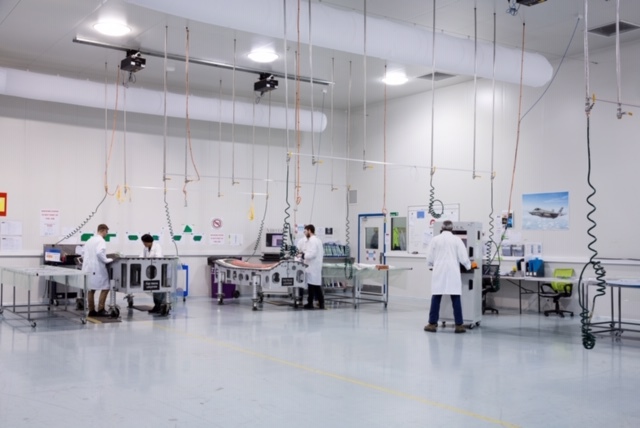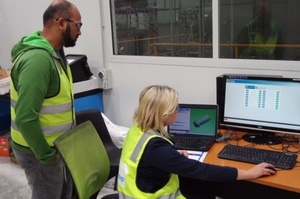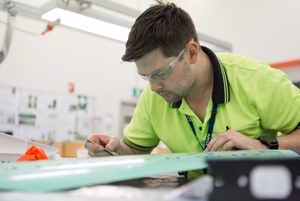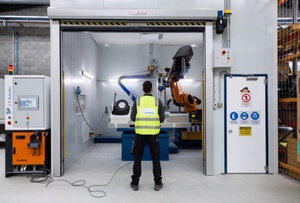

|
Edward Lowton
Editor |


|
| Home> | Efficient Maintenance | >Maintenance products | >Halves set up time |
| Home> | Production Engineering | >Quality and tolerance testing | >Halves set up time |
| Home> | Efficient Maintenance | >Software | >Halves set up time |
Halves set up time
07 February 2019
MSP’s software is delivering cost and time savings for Quickstep Technologies’ composite manufacturing processes in Australia.

MSP develops and implements precision metrology software, helping companies within sectors such as aerospace, Formula 1, and defence, produce 100% accurate parts.
An independent aerospace grade advanced composites manufacturer, Quickstep Technologies is located in Bankstown, New South Wales, Australia, and has a global reach. It provides complex composite part manufacture and assemblies for ‘build to print’ applications, making use of conventional autoclave-based manufacturing and proprietary out-of-autoclave production techniques including its patented https://www.quickstep.com.au/Capabilities/Quickstep-Curing-Process QURE process. In addition, Quickstep Technologies provides design, development and manufacture of complex engineered products.
Quickstep Technologies provides advanced composite solutions to customers including Northrop Grumman, for whom it is an approved supplier for the international F-35 Lightning II Joint Strike Fighter (JSF) program. The company is a supplier of composite wing flaps to Lockheed Martin for the military C-130J ‘Super Hercules’ and commercial LM-100J transport aircraft contracts, which have recently been extended to 2024. It also works closely with BAE Systems PLC and Boeing Defense.
Background
The JSF program requires the supply of high-precision composite manufacturing and involves a high degree of precision machining, specifically five-axis work for parts, and therefore consistency, qualification, documentation and traceability were pre-requisites for this contract. Confidence in the machining and quality process was also paramount and both Quickstep Technologies and its customer had to be confident that the equipment and processes could deliver the job.
At its state-of-the-art aerospace manufacturing facility at Bankstown airport, Quickstep Technologies introduced NC-Checker and NC-PerfectPart to monitor the accuracy and capability of its five-axis machining. Doing so also enabled Quickstep Technologies to qualify its Breton five-axis machining centres and give their customers the confidence that Quickstep’s manufacturing processes meet their exacting standards.
Implementation of MSP’s NC-PerfectPart and NC-Checker software, supported by probing technology, provides the detailed information required to ensure machines stay within specified parameters and improves set-up times for Quickstep Technologies’ complex free-form parts.
NC-Checker first carries out a calibration check on the probe. Once this is complete, it then proceeds to carry out five-axis checks of the machine tool to check the machine’s accuracy. This produces a benchmark report which shows the manufacturer if their machine is capable of machining parts to tolerance. The software provides detailed results in a comprehensive report and can show precisely where the machine may be under-performing. This check takes minutes to complete, meaning it can be run on a regular basis to provide routine monitoring of the machine’s geometry.
The parts being produced by Quickstep Technologies are complex free form shapes, so work-holding is a major issue when using traditional manufacturing methods. Each part has a dedicated composite vacuum fixture with three or four fixed location Tooling Spheres. The centre point of the spheres are known relative to the part geometry and this information is then used to locate the fixture or part in a suitable work offset coordinate system for machining. NC-PerfectPart fully automates this process and eliminates any human error. NC-PerfectPart removes the need to precisely position the part, saving significant time in setup.
Results
Kris Dokka, specialist manager, Quickstep Technologies says: “The initial results of using NC-PerfectPart and NC-Checker were a surprise; in the sense that we could now fully automate our datum setting and verification process and reduce this setup time by 50% per part (when compared to the previous method), as well as clearly understand the various geometry features and the accuracies inter-relation to each other.”
“Customising a programme within NC-PerfectPart, also resulted in a considerable reduction of rework on surface profile inaccuracies. Last year we achieved a 75% reduction in this rework and this year are aiming for Gold.”
“With the ease of use of the software we now have a scheduled fortnightly benchmark execution routine. In addition to this regular scheduled check, we also execute a complete benchmark routine if there is an untoward incident on any of the machines, to determine if any changes occurred in the machine geometric accuracies. This is the most efficient method of gaining confidence back in the machine accuracy status before we commit to machining a part.”
“Assessing the machine using our old methods could take anywhere between 2 and 4 days to complete, and, even then, we still couldn’t easily generate readable documentation of the results to be used for further analysis. With NC-Checker, and the use of a Renishaw RMP600 radio probe, we have simplified the procedure greatly. As a result, we can now complete this check in 1 to 2h, a saving of up to 96%, freeing up valuable machine time and improving productivity. Furthermore, the data that we can now generate and the history that we are building means that we can plot trends. This in turn helps us with critical decision making regarding periodic machine maintenance schedules and alignment activities.”
In addition to being able to quickly qualify the geometric accuracy of a machine, the other key benefit of running NC-Checker is to give the user confidence that the machine is performing exactly as it is expected to in terms of axes positioning, which is particularly relevant in five-axis environments. Kris continues: “As the software is used prior to any machining, it provides us with assurance about our processes. We can understand if the machine is still capable of producing parts to the required geometric tolerances. Part analysis can be also conducted before any cutting, eliminating uncertainty and possible costly rework and/or scrap.”
Summary
Kris Dokka concludes: “Introducing NC-Checker and NC-PerfectPart means our customers have increased confidence thanks to the transparency of documents evidencing machine health and accuracies. As our customers use the same methodologies that we do now, it makes communication about these matters easy. The automation of our part setup – achieving a time saving of 50%, and the customisation of our part alignment -– achieving a 75% reduction in rework; not only makes our processes more efficient but reduces costs. We also gain real-time knowledge of the geometric accuracy of the machines in 1 to 2h rather than 3 to 4 days, freeing up valuable machine time and giving us the confidence that the machine/component setup is as good as is required.”
Quickstep Technologies will include the full range of MSP software as well as the soon-to-be-released MSP plug-in NC Inspect, which simplifies the generation of probing programmes from CAD systems as standard on all future five-axis machines.
- No related articles listed





















